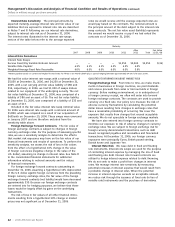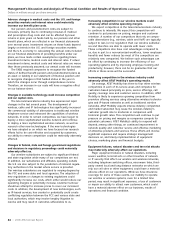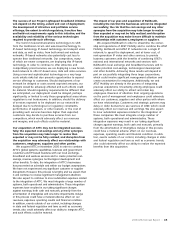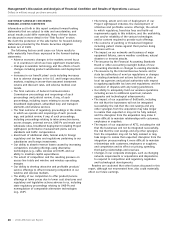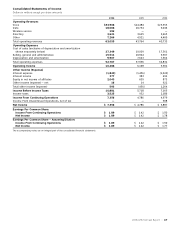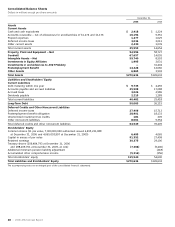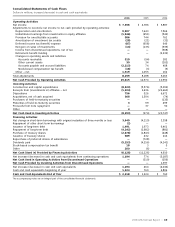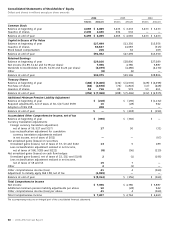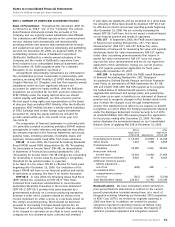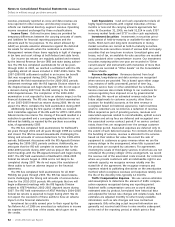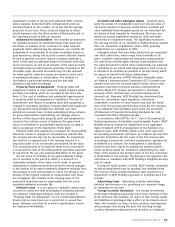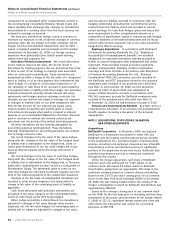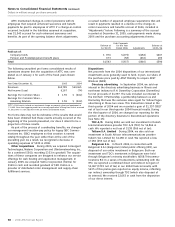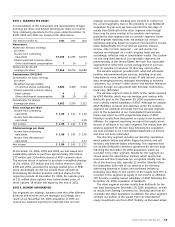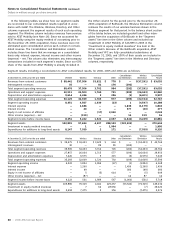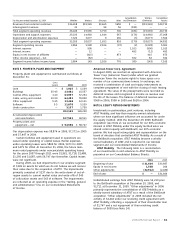AT&T Wireless 2006 Annual Report Download - page 53
Download and view the complete annual report
Please find page 53 of the 2006 AT&T Wireless annual report below. You can navigate through the pages in the report by either clicking on the pages listed below, or by using the keyword search tool below to find specific information within the annual report.
2006 AT&T Annual Report : :
51
Notes to Consolidated Financial Statements
Dollars in millions except per share amounts
NOTE 1. SUMMARY OF SIGNIFICANT ACCOUNTING POLICIES
Basis of Presentation Throughout this document, AT&T Inc.
is referred to as “AT&T,” “we” or the “Company.” The consoli-
dated financial statements include the accounts of the
Company and our majority-owned subsidiaries and affiliates.
Our subsidiaries and affiliates operate in the communications
services industry both domestically and internationally
providing wireline and wireless telecommunications services
and equipment as well as directory advertising and publishing
services. On December 29, 2006, we acquired 100% of the
outstanding common shares of BellSouth Corporation
(BellSouth). BellSouth is a wholly-owned subsidiary of the
Company and the results of BellSouth’s operations have
been included in our consolidated financial statements after
the December 29, 2006 acquisition date. For a detailed
discussion of our acquisition, see Note 2.
All significant intercompany transactions are eliminated in
the consolidation process. Investments in partnerships, joint
ventures, including AT&T Mobility LLC (AT&T Mobility), formerly
Cingular Wireless LLC (Cingular), and less than majority-owned
subsidiaries where we have significant influence are
accounted for under the equity method. Until the BellSouth
acquisition, we accounted for our 60% economic interest in
AT&T Mobility under the equity method since we shared
control equally with BellSouth, our 40% economic partner.
We had equal voting rights and representation on the board
of directors that controlled AT&T Mobility. After the BellSouth
acquisition, AT&T Mobility became a wholly-owned subsidiary
of AT&T. Earnings from certain foreign equity investments
accounted for using the equity method are included for
periods ended within up to one month of our year end
(see Note 6).
The preparation of financial statements in conformity with
U.S. generally accepted accounting principles (GAAP) requires
management to make estimates and assumptions that affect
the amounts reported in the financial statements and accom-
panying notes, including estimates of probable losses and
expenses. Actual results could differ from those estimates.
FIN 48 In June 2006, the Financial Accounting Standards
Board (FASB) issued FASB Interpretation No. 48, “Accounting
for Uncertainty in Income Taxes” (FIN 48), an interpretation
of Statement of Financial Accounting Standards No. 109,
“Accounting for Income Taxes.” FIN 48 changes the accounting
for uncertainty in income taxes by prescribing a recognition
threshold for tax positions taken or expected
to be taken in a tax return. FIN 48 is effective for fiscal years
beginning after December 15, 2006. Our evaluation of the
impact FIN 48 will have on our financial position and results
of operations is ongoing. See Note 9 for further discussion.
EITF 06-3 In June 2006, the Emerging Issues Task Force
(EITF) ratified the consensus on EITF 06-3, “How Taxes
Collected from Customers and Remitted to Governmental
Authorities Should Be Presented in the Income Statement”
(EITF 06-3). EITF 06-3 provides that taxes imposed by a
governmental authority on a revenue producing transaction
between a seller and a customer should be shown in the
income statement on either a gross or a net basis, based on
the entity’s accounting policy, which should be disclosed
pursuant to Accounting Principles Board Opinion No. 22,
“Disclosure of Accounting Policies.” Amounts that are allowed
to be charged to customers as an offset to taxes owed by a
company are not considered taxes collected and remitted.
If such taxes are significant, and are presented on a gross basis,
the amounts of those taxes should be disclosed. EITF 06-3 will
be effective for interim and annual reporting periods beginning
after December 15, 2006. We are currently evaluating the
impact EITF 06-3 will have, but do not expect a material impact
on our financial position and results of operations.
FAS 157 In September 2006, the FASB issued Statement
of Financial Accounting Standard No. 157, “Fair Value
Measurements” (FAS 157). FAS 157 defines fair value,
establishes a framework for measuring fair value and expands
disclosures about fair value measurements. FAS 157 applies
under other accounting pronouncements that require or
permit fair value measurement. FAS 157 does not require
any new fair value measurements and we do not expect the
application of this standard to change our current practice.
FAS 157 requires prospective application for fiscal years
ending after November 15, 2007.
FAS 158 In September 2006, the FASB issued Statement
of Financial Accounting Standard No. 158, “Employers’
Accounting for Defined Benefit Pension and Other Postretire-
ment Plans, an amendment of FASB Statements No. 87, 88,
106 and 132(R)” (FAS 158). FAS 158 required us to recognize
the funded status of defined benefit pension, including
supplemental retirement and savings plans, and postemploy-
ment plans as an asset or liability in our statement of financial
position and to recognize changes in that funded status in the
year in which the changes occur through comprehensive
income. This standard has no effect on our expense or benefit
recognition, nor will it affect the funding requirements imposed
under the Employee Retirement Income Security Act of 1974,
as amended (ERISA). FAS 158 requires prospective application
for fiscal years ending after December 15, 2006. The table
below illustrates the incremental impact on our Consolidated
Balance Sheet of applying FAS 158 at December 31, 2006.
Before After
Application Application
of FAS 158 Adjustments of FAS 158
Postemployment Benefit $ 19,118 $(4,890) $ 14,228
Other Assets 7,003 (138) 6,865
Postretirement benefit
obligation 25,485 3,416 28,901
Noncurrent deferred
income taxes 31,100 (3,694) 27,406
Other noncurrent liabilities 8,020 41 8,061
Additional minimum pension
liability adjustment –
net of tax (208) 208 —
Accumulated other
comprehensive income –
net of tax (315) (4,999) (5,314)
Total Stockholders’ Equity 120,331 (4,791) 115,540
Reclassifications We have reclassified certain amounts in
prior-period financial statements to conform to the current
period’s presentation. Included among these, as a result of
integration activities following our November 2005 acquisition
of AT&T Corp. (ATTC), we revised our segment reporting in
2006 (see Note 4). In addition, we revised the product
categories reported in operating revenue as follows: long
distance is now reported in voice revenue; the majority of
customer premises equipment and integration services



